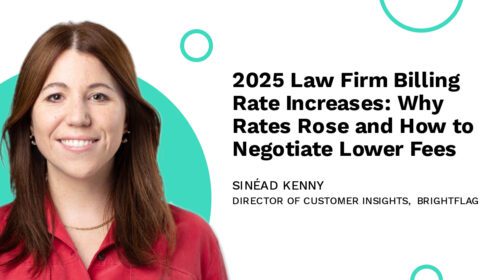5 Ways GCs Can Mitigate the Impact of Outside Counsel Rate Increases
While the pace of outside counsel rate increases has slowed from last year’s historic surge, Brightflag’s 2025 Timekeeper Rates Report showed a still-significant 8.3% rise in blended hourly rates across Am Law 100 firms.
Though timekeeper rate increases can be anxiety-inducing for General Counsel—especially if they’re working with tight legal budgets—there are levers they can pull to both mitigate the impacts of these rate increases and further optimize their partnerships with outside counsel.
Jeff Barlow, General Counsel at Momentive Technologies, has developed several such strategies. Using real-time data and proactive communication, Jeff has created a structured approach to rate negotiation and law firm management. And in a recent Brightflag webinar, Jeff shared how he uses legal spend analytics to drive value, maintain predictability, and strengthen relationships with outside counsel.
Here’s what other GCs can learn from his playbook.
1. Set Expectations Early and Transparently
Barlow emphasized the importance of proactively setting the tone with outside counsel firms before rate increases are requested. Each year, his team sends an “annual letter” to their legal service providers outlining:
- The legal department’s key achievements and priorities
- Planned initiatives or RFPs for the coming year
- Billing expectations, including a clearly stated rate increase cap
- Reinforcement of outside counsel billing guidelines
“We said that we would not accept any rate increase above 5%,” Barlow said. “We looked at industry data, including Brightflag’s Am Law 100 Rates report, and felt comfortable setting that cap. It became a clear boundary for the firms we work with.”
This letter not only establishes financial boundaries but also reinforces the importance of partnership and accountability—by recognizing high-performing firms and providing transparency around future needs.
2. Use Timekeeper Data as a Negotiation Anchor
While setting a percentage cap on rate increases can help control costs, it’s the use of granular data that truly empowers rate negotiations.
Jeff’s team doesn’t just track overall firm spend—they analyze rates at the individual timekeeper level. This allows them to:
- Enforce rate increase limits more precisely
- Identify outliers among timekeepers or firms
- Spot when unapproved timekeepers are billing matters
- Ensure rate changes reflect true progression (e.g., associate → partner)
“We had too many invoices coming in with timekeepers that were either unapproved or had no approved rate. That’s how spend sneaks up on you,” Barlow noted. “Now, we’ve moved those situations to auto-reject in our e-billing system.”
For in-house teams, having access to historical and benchmarked timekeeper data is essential. It enables not only informed negotiations but also better forecasting and budgeting.
3. Reward Performance and Push for Accountability
When firms do request increases above the stated cap, Barlow doesn’t immediately say no—but he does ask for justification.
“We do ask them to produce data to back up why their costs are rising so much,” he said. “If they can’t justify it, we’ll push back. And if they continue pushing, we make a note—we might need to consider other options next year.”
This approach allows for flexibility when warranted, while maintaining control over overall spend. It also signals that cost-effectiveness and value delivery are core expectations in the relationship with outside counsel law firms.
4. Look Beyond Rates to Total Resourcing Strategy
Rate increases are just one piece of the cost control puzzle. Another lever Barlow pulls is firm selection. His team regularly evaluates:
- Firm size and geographic location (e.g. Midwest firms generally offer lower hourly rates)
- Use of alternative legal service providers (ALSPs)
- Resourcing models (e.g., partner vs. associate-heavy staffing)
- Fixed-fee or AFA options for repeatable work
“Not everything needs to come out of New York,” Barlow joked. “There are great lawyers everywhere. You just have to put in the work to find them.”
To uncover opportunities for cost-effective resourcing, Momentive runs RFPs, reviews law firm performance across different matters, and stays open to new partners who demonstrate value.
5. Leverage Technology to Operationalize the Strategy
Technology is what makes this level of sophistication scalable. Barlow uses Brightflag to track timekeeper rates, monitor billing guideline compliance, and generate actionable reports.
“The data Brightflag showed us gave us concrete proof that some of the firms we were using—who we thought were cost-effective—really were,” he said. “That allowed us to expand work with those firms confidently.”
He also noted that Brightflag’s AI-driven invoice review and auto-rejection features have significantly reduced time spent managing billing exceptions, enabling the legal team to focus on higher-value work.
Final Takeaway: Speaking the Language of Cost and Value Enhances Legal Strategy
Rate benchmarking data is not just a defensive tool—it’s a foundation for strategic decision-making. By embedding this data into rate negotiations, vendor selection, and budgeting processes, GCs can control costs without sacrificing quality.
As Jeff put it:
“If we can’t explain where our costs are, and how we manage them, we’re not being a good corporate steward of the legal function.”
With the right mindset and the right tools, legal leaders can gain visibility, foster accountability, and deliver long-term value to the business.
If you’re curious to see firsthand how Brightflag can help, book a demo with us today.


